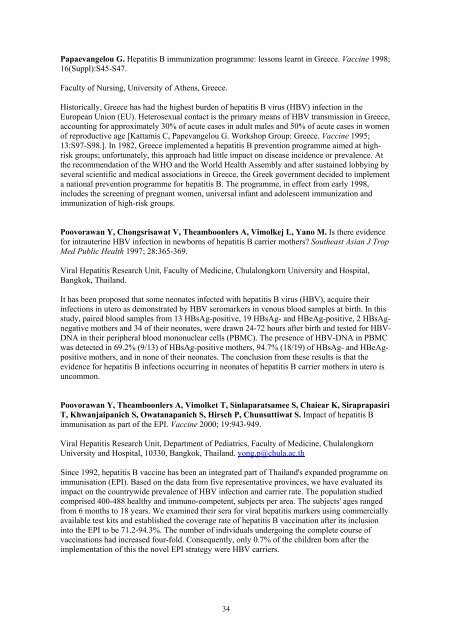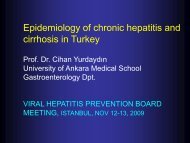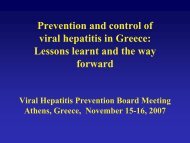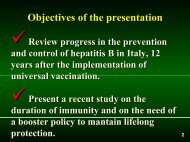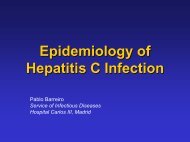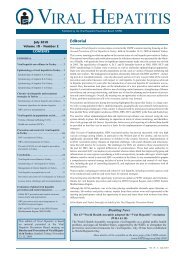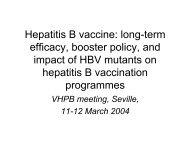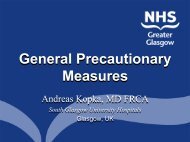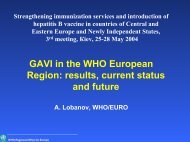Papaevangelou G. Hepatitis B immunization programme: lessons learnt <strong>in</strong> Greece. Vacc<strong>in</strong>e 1998;16(Suppl):S45-S47.Faculty <strong>of</strong> Nurs<strong>in</strong>g, University <strong>of</strong> Athens, Greece.Historically, Greece has had the highest burden <strong>of</strong> <strong>hepatitis</strong> B <strong>virus</strong> (HBV) <strong>in</strong>fection <strong>in</strong> theEuropean Union (EU). Heterosexual contact is the primary means <strong>of</strong> HBV <strong>transmission</strong> <strong>in</strong> Greece,account<strong>in</strong>g for approximately 30% <strong>of</strong> acute cases <strong>in</strong> adult males <strong>and</strong> 50% <strong>of</strong> acute cases <strong>in</strong> women<strong>of</strong> reproductive age [Kattamis C, Papevangelou G. Workshop Group: Greece. Vacc<strong>in</strong>e 1995;13:S97-S98.]. In 1982, Greece implemented a <strong>hepatitis</strong> B prevention programme aimed at highriskgroups; unfortunately, this approach had little impact on disease <strong>in</strong>cidence or prevalence. Atthe recommendation <strong>of</strong> the WHO <strong>and</strong> the World Health Assembly <strong>and</strong> after susta<strong>in</strong>ed lobby<strong>in</strong>g byseveral scientific <strong>and</strong> medical associations <strong>in</strong> Greece, the Greek government decided to implementa national prevention programme for <strong>hepatitis</strong> B. The programme, <strong>in</strong> effect from early 1998,<strong>in</strong>cludes the screen<strong>in</strong>g <strong>of</strong> pregnant women, universal <strong>in</strong>fant <strong>and</strong> adolescent immunization <strong>and</strong>immunization <strong>of</strong> high-risk groups.Poovorawan Y, Chongsrisawat V, Theamboonlers A, Vimolkej L, Yano M. Is there evidencefor <strong>in</strong>trauter<strong>in</strong>e HBV <strong>in</strong>fection <strong>in</strong> newborns <strong>of</strong> <strong>hepatitis</strong> B carrier mothers? Southeast Asian J TropMed Public Health 1997; 28:365-369.Viral Hepatitis Research Unit, Faculty <strong>of</strong> Medic<strong>in</strong>e, Chulalongkorn University <strong>and</strong> Hospital,Bangkok, Thail<strong>and</strong>.It has been proposed that some neonates <strong>in</strong>fected with <strong>hepatitis</strong> B <strong>virus</strong> (HBV), acquire their<strong>in</strong>fections <strong>in</strong> utero as demonstrated by HBV seromarkers <strong>in</strong> venous blood samples at birth. In thisstudy, paired blood samples from 13 HBsAg-positive, 19 HBsAg- <strong>and</strong> HBeAg-positive, 2 HBsAgnegativemothers <strong>and</strong> 34 <strong>of</strong> their neonates, were drawn 24-72 hours after birth <strong>and</strong> tested for HBV-DNA <strong>in</strong> their peripheral blood mononuclear cells (PBMC). The presence <strong>of</strong> HBV-DNA <strong>in</strong> PBMCwas detected <strong>in</strong> 69.2% (9/13) <strong>of</strong> HBsAg-positive mothers, 94.7% (18/19) <strong>of</strong> HBsAg- <strong>and</strong> HBeAgpositivemothers, <strong>and</strong> <strong>in</strong> none <strong>of</strong> their neonates. The conclusion from these results is that theevidence for <strong>hepatitis</strong> B <strong>in</strong>fections occurr<strong>in</strong>g <strong>in</strong> neonates <strong>of</strong> <strong>hepatitis</strong> B carrier mothers <strong>in</strong> utero isuncommon.Poovorawan Y, Theamboonlers A, Vimolket T, S<strong>in</strong>laparatsamee S, Chaiear K, SiraprapasiriT, Khwanjaipanich S, Owatanapanich S, Hirsch P, Chunsuttiwat S. Impact <strong>of</strong> <strong>hepatitis</strong> Bimmunisation as part <strong>of</strong> the EPI. Vacc<strong>in</strong>e 2000; 19:943-949.Viral Hepatitis Research Unit, Department <strong>of</strong> Pediatrics, Faculty <strong>of</strong> Medic<strong>in</strong>e, ChulalongkornUniversity <strong>and</strong> Hospital, 10330, Bangkok, Thail<strong>and</strong>. yong.p@chula.ac.thS<strong>in</strong>ce 1992, <strong>hepatitis</strong> B vacc<strong>in</strong>e has been an <strong>in</strong>tegrated part <strong>of</strong> Thail<strong>and</strong>'s exp<strong>and</strong>ed programme onimmunisation (EPI). Based on the data from five representative prov<strong>in</strong>ces, we have evaluated itsimpact on the countrywide prevalence <strong>of</strong> HBV <strong>in</strong>fection <strong>and</strong> carrier rate. The population studiedcomprised 400-488 healthy <strong>and</strong> immuno-competent, subjects per area. The subjects' ages rangedfrom 6 months to 18 years. We exam<strong>in</strong>ed their sera for viral <strong>hepatitis</strong> markers us<strong>in</strong>g commerciallyavailable test kits <strong>and</strong> established the coverage rate <strong>of</strong> <strong>hepatitis</strong> B vacc<strong>in</strong>ation after its <strong>in</strong>clusion<strong>in</strong>to the EPI to be 71.2-94.3%. The number <strong>of</strong> <strong>in</strong>dividuals undergo<strong>in</strong>g the complete course <strong>of</strong>vacc<strong>in</strong>ations had <strong>in</strong>creased four-fold. Consequently, only 0.7% <strong>of</strong> the children born after theimplementation <strong>of</strong> this the novel EPI strategy were HBV carriers.34
Ranger-Rogez S, Ala<strong>in</strong> S, Denis F. Hepatitis <strong>virus</strong>es: mother-to-child <strong>transmission</strong>. Pathol Biol(Paris) 2002; 50:568-575. [Article <strong>in</strong> French]Laboratoire de virologie, CHU Dupuytren, 87042, Limoges, France. sylvie.rogez@unilim.frThe <strong>in</strong>fection by the <strong>hepatitis</strong> <strong>virus</strong>es, when appear<strong>in</strong>g dur<strong>in</strong>g the pregnancy, could result <strong>in</strong>damages for the <strong>in</strong>fant. However, risks differ accord<strong>in</strong>g to the implicated <strong>virus</strong>. Hepatitis B <strong>virus</strong><strong>in</strong>fection, for which prevalence varies accord<strong>in</strong>g to areas, is <strong>in</strong>jurious when the mother is chronicHBsAg carrier. Risk consists <strong>of</strong> neonate's contam<strong>in</strong>ation dur<strong>in</strong>g the labour, <strong>and</strong> if contam<strong>in</strong>ated,the neonate becomes a chronic carrier himself <strong>in</strong> 80 to 90% <strong>of</strong> cases. When the mother is positivefor viral DNA <strong>in</strong> her serum, <strong>transmission</strong> rate is estimated at 90%. In the opposite, if the mother isnegative for viral DNA <strong>in</strong> the serum, <strong>transmission</strong> rate is about 10 to 30%. HBsAg screen<strong>in</strong>g isobligatory <strong>in</strong> France dur<strong>in</strong>g the sixth month <strong>of</strong> pregnancy: <strong>in</strong> case <strong>of</strong> positivity, serovacc<strong>in</strong>ation <strong>of</strong>the neonate is systematically carried out. Protection rate is 100% if the mother had a low viral load(< 150 pg/ml) at the end <strong>of</strong> pregnancy, <strong>and</strong> weaker (about 70%) if the mother had a higher level <strong>of</strong>viral DNA.Transmission risk <strong>of</strong> <strong>hepatitis</strong> C <strong>virus</strong> (HCV) is much lesser, s<strong>in</strong>ce it is about 5% for awoman who is positive for viral RNA at the end <strong>of</strong> her pregnancy, <strong>and</strong> at least 10% if the womanis moreover positive for the HIV. Risk is more important if the woman had an important plasmaticviral load (> 10 5 copies/ml) <strong>and</strong> if the duration between membrane rupture <strong>and</strong> delivery is long.Vag<strong>in</strong>al delivery <strong>and</strong> breast-feed<strong>in</strong>g are not advised. Neonates from mothers who replicate theHCV at the end <strong>of</strong> pregnancy are serologically evaluated until 12-15 months <strong>of</strong> age, <strong>in</strong> order todeterm<strong>in</strong>e their possible contam<strong>in</strong>ation.Delta <strong>virus</strong> <strong>transmission</strong> from mother to <strong>in</strong>fant isexceptional <strong>and</strong> could be avoided by the HBV serovacc<strong>in</strong>ation <strong>of</strong> the new-born.Intra-utero<strong>transmission</strong> <strong>of</strong> <strong>hepatitis</strong> A <strong>virus</strong> is very rare, but <strong>per<strong>in</strong>atal</strong> <strong>transmission</strong> could occur. Materno-fetal<strong>transmission</strong> <strong>of</strong> <strong>hepatitis</strong> E <strong>virus</strong> has been reported, but the <strong>virus</strong> is essentially dangerous for themother, result<strong>in</strong>g <strong>in</strong> a mortality rate <strong>of</strong> 15 to 25% if the acute <strong>in</strong>fection occurs dur<strong>in</strong>g the thirdtrimester <strong>of</strong> the pregnancy.Ranger-Rogez S, Denis F. Hepatitis B mother-to-child <strong>transmission</strong>. Expert Rev Anti-<strong>in</strong>fectiveTher 2004; 2:133-145.Laboratoire de Virologie, CHU Dupuytren, 2 Avenue Mart<strong>in</strong> Luther K<strong>in</strong>g, 87042 Limoges Cedex,France. sylvie.rogez@unilim.frApproximately 350 million people are estimated to be chronically <strong>in</strong>fected with <strong>hepatitis</strong> B <strong>virus</strong>,lead<strong>in</strong>g to an important public health problem. In highly endemic areas where 8 to 15% <strong>of</strong> peopleare chronically <strong>in</strong>fected with <strong>hepatitis</strong> B <strong>virus</strong>, the risk for the neonate to be <strong>per<strong>in</strong>atal</strong>ly <strong>in</strong>fected bythe chronically <strong>in</strong>fected mother, then to become chronically <strong>in</strong>fected themselves, is very high. Inthose countries, the World Health Organization recommends <strong>hepatitis</strong> B vacc<strong>in</strong>ation systematicallyat birth, <strong>in</strong>dependent <strong>of</strong> <strong>hepatitis</strong> B <strong>virus</strong> maternal status. This vacc<strong>in</strong>ation program has begun to<strong>in</strong>duce a rapid decrease <strong>in</strong> the number <strong>of</strong> acute <strong>hepatitis</strong> B <strong>virus</strong> <strong>in</strong>fections <strong>and</strong> has also had asecondary effect <strong>of</strong> a decrease <strong>in</strong> related sequels. Lamivud<strong>in</strong>e (Zeffix, GlaxoSmithKl<strong>in</strong>e), whenassociated with the immunization <strong>of</strong> the neonate, was recently demonstrated to dramatically reducethe residual risk <strong>of</strong> <strong>per<strong>in</strong>atal</strong> <strong>transmission</strong>. In <strong>in</strong>termediate <strong>and</strong> low endemicity areas, a systematic<strong>hepatitis</strong> B surface antigen screen<strong>in</strong>g is recommended dur<strong>in</strong>g pregnancy, allow<strong>in</strong>g, <strong>in</strong> the case <strong>of</strong>positivity, a selective <strong>hepatitis</strong> B <strong>virus</strong> neonate immunization dur<strong>in</strong>g the first 12 h <strong>of</strong> life. HepatitisB <strong>virus</strong> vacc<strong>in</strong>ation <strong>of</strong> children born to <strong>hepatitis</strong> B surface antigen-positive mothers confers longtermimmunity.35
- Page 1 and 2: Pre-meeting documentPrevention and
- Page 3 and 4: Part I Prevention and control of pe
- Page 5 and 6: prevalence was significantly higher
- Page 7 and 8: clusters (obstetrics wards/hospital
- Page 9 and 10: Boxall E. Screening of pregnant wom
- Page 11 and 12: Chang MH, Hsu HY, Huang LM, Lee PI,
- Page 13 and 14: of infection in infants and childre
- Page 15 and 16: Eriksen EM, Perlman JA, Miller A, M
- Page 17 and 18: liver enzyme abnormalities than wer
- Page 19 and 20: health care, is feasible and achiev
- Page 21 and 22: HBsAg and anti-HBs in 4.5%. In the
- Page 23 and 24: immunoprophylaxis. Reflecting effec
- Page 25 and 26: Levin CE, Nelson CM, Widjaya A, Mon
- Page 27 and 28: Delaying vaccination of premature i
- Page 29 and 30: diagnosis. In the past, the inciden
- Page 31 and 32: shows that the prevalence of HBV in
- Page 33: Niu MT, Targonski PV, Stoll BJ, Alb
- Page 37 and 38: vaccinees) and low reactogenicity o
- Page 39 and 40: single ELISA test is about Rs40. At
- Page 41 and 42: newborns with surface antigenemia,
- Page 43 and 44: Wang Z, Zhang J, Yang H, Li X, Wen
- Page 45 and 46: of hepatitis B vaccine. This study
- Page 47 and 48: transmission has been estimated at
- Page 49 and 50: at birth and 2 weeks after birth, f
- Page 51 and 52: Chubinishvili OV, Mikhailov MI, Sak
- Page 53 and 54: Jensen L, Heilmann C, Smith E, Want
- Page 55 and 56: Onishchenko GG. Incidence of infect
- Page 57: Zanetti A, Tanzi E, Semprini AE. He


